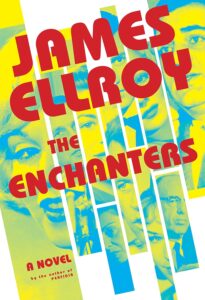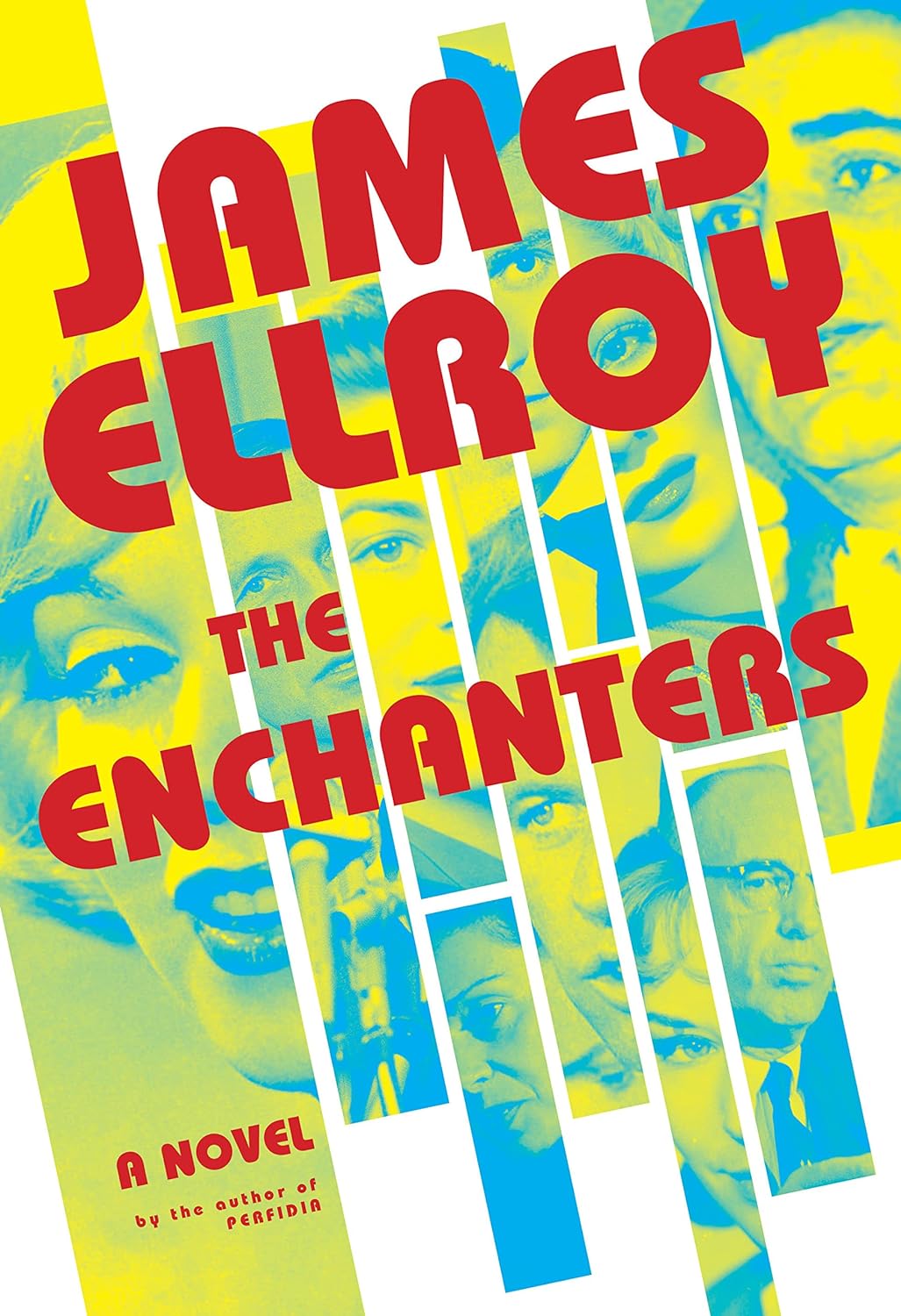 James Ellroy’s newest novel, The Enchanters, brings us back into the life and mind of Fred Otash, which we have encountered in earlier works like Blood’s a Rover. Otash, for the uninitiated, is a disgraced former LA cop and private investigator who extorts and cons his way through the LA underworld. He’s a drug addict and boozer, a buyer and seller of filthy celebrity gossip—a complete antihero, but one with the slightest of soft spots for certain vulnerable people.
James Ellroy’s newest novel, The Enchanters, brings us back into the life and mind of Fred Otash, which we have encountered in earlier works like Blood’s a Rover. Otash, for the uninitiated, is a disgraced former LA cop and private investigator who extorts and cons his way through the LA underworld. He’s a drug addict and boozer, a buyer and seller of filthy celebrity gossip—a complete antihero, but one with the slightest of soft spots for certain vulnerable people.
The book begins with Otash’s death in 1992. We are privy to a confidential memo, written to LA Police Chief Darryl Gates, assuring him that Otash’s activities on behalf of the LAPD in the summer of 1962 will remain forever secret now that Otash is gone and those who knew him don’t appear interested in talking about what happened thirty years earlier. At that time, Gates who was a lieutenant with the department, and the suggestion is that he was up to no good.
What are Otash’s secrets? Well, turn the page and get whisked back 30 years. LA is broiling. A minor film star has been kidnapped and Otash is dispatched by LA Police Chief William Parker to assist the “Hat Squad,” a notoriously rough set of LAPD detectives, to rough up the leading suspect and find the girl… They end of tossing him off a cliff, before they find the kidnapped actress.
The whole thing seems like a publicity stunt, which bothers Otash. Before he can do anything more, Peter Lawford calls him in tears to explain that Marylin Monroe is dead. Otash calls Parker, who tells him to go to Monroe’s house and do a complete forensic sweep of the scene. Parker smells blackmail opportunities and puts Otash on the scent.
Why is the chief of the LAPD assigning the Monroe crime scene to a disreputable extortionist? From a previous book, we know that Parker has a hold over Otash. He can put Otash away for a host of crimes, but instead of arresting him, Parker is blackmailing Otash into doing his dirty work. Parker also knows that Otash has already been spying on Monroe, so it’s not a big leap to send him off on this questionable errand.
Jump back a few months, to the spring of 1962. The big story around town is that Twentieth Century Fox is collapsing under the weight of the disastrous film Cleopatra, with Elizabeth Taylor. Marylin Monroe, then one of the most famous film stars in the world, is spiraling out of control on pills and booze. She’s rumored to be having an affair with President John F Kennedy.
Jimmy Hoffa, in a blood feud with Robert Kennedy, hires Otash to get the dirt on Monroe and JFK so he can blackmail them into quashing their investigation into the Teamsters Union. Otash and his team plant bugs in Monroe’s house, as well as at Lawford’s. Lawford is married to Patricia Kennedy, the president’s brother and a long-ago lover of Fred Otash.
This launches the first major segment of the book, which is a long, drawn-out procession of voyeuristic scenes of Monroe as she passes out in her trailer, has sex with pizza delivery men and engages in a lot of strange, suspicious behaviors. She’s sneaking around in outfits that make her look fat and ugly. She makes calls from payphones.
The book is in the first person, showing everything from Otash’s addled point of view. He’s a peeper, and he’s peeping on the white-hot glamour queen of the America. And, as he says, he learns not to like her. Ellroy is playing on our fascination with Monroe, and the truth is, you probably won’t like her, either, but you’re going to be spending a good hundred pages following her around and listening to her phone calls. The book may lose you at that point.
Then, she’s dead, and you can feel that the era we (naively) refer to as “Camelot” is about to collapse into the phantasmagoria of the sixties. Monroe’s death is the catalyst for a sprawling, deranged series of interconnected crimes and intrigues that make up the remainder of the book. Otash is trying to solve the bogus kidnap caper, which involves a high suspicious actress named Gwen Perlow. She’s having an affair with Daryl Zanuck, who himself is facing a financial catastrophe with Cleopatra. Sexual psychopaths abound. Bent cops and odious, pill pushing shrinks cash in…
The book follows Otash as he tries to unravel the byzantine mysteries—and save himself from trouble. All that wiretapping is illegal, of course, and he’s been caught by Parker and Bobby Kennedy. They put the screws to him to come up with enough dirt on Monroe to muddy any claim that she had sex with the president… the whole book is all driven by black mail, one way or another.
Ellroy is an acquired taste. His style has been called “staccato.” He’s sort of writing in verse, a stream of consciousness from someone who’s nipping from whiskey flasks and “popping bennies,” as taking speed was called in that era. His mind works frenetic. He’s obsessive and compulsive. He has a “man camera” that records crime scene images in his brain for later review. This is not for everyone.
I have read many of Ellroy’s books, so the style is familiar to me. I mostly find it fun and, at times, brilliant. It’s all “Hey, hepcat, I gassed on the gestalt” and ring-a-ding-ding, baby. It can be grating, though. I couldn’t finish Perfidia, for example. What Ellroy is doing is to take us back to the mindset of the times, to see the early sixties from the point of view of someone who was bottom feeding and sniffing the filth.
This book begs the question, at least to me, of why this era is so fascinating for us. Why are books about JFK and Marylin so common? What’s the curiosity. Just this week, there was yet another controversy about secret documents related to the Kennedy assassination, which was a full 60 years ago. What gives?
I think part of it is a sense that the country went through a change just after this period that it’s never quite recovered from. America was so categorically different in 1992 than it had been in 1962. Certainly, the country changed far less from 1992 to today. It was a different place, though, as Ellroy shows us in such detail, it was not a “simpler time.” It was plenty complicated, with all sorts of pathologies and disgusting behavior going on. What was different was the surface. People hid stuff better back then, though prejudices were on more open display. Otash calls gays “fruits,” for example, an ugly label that no longer flies, and that’s a good thing.
I have a very slim connection to this story. In 1992, I was working for TV producer Edgar Scherick, who was president of ABC in 1962. He could have been a walk on character in this book. He knew Zanuck. I had learned the story of Fox and Cleopatra from him—that LA’s Century City office complex is so named because it was the back lot of the 20th Century Fox studio, a property they had to sell to avoid going bankrupt after spending $44 million on Cleopatra, one of most expensive movies ever made.
And this is where Ellroy has the potential to get into trouble. He fictionalizes real people. Bill Parker was a real person. So was Darryl Gates. Was Parker really a drunk, as Ellroy has him? Was Gates a crook, as Ellroy depicts? I don’t know. Otash was a real person, too. His exploits here are probably 90% made up and 10% ginned up from rumors and urban myths. I don’t really care, but it’s not necessarily a good practice, in literary terms. The dead can’t complain, and maybe that’s not fair.
